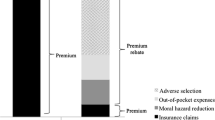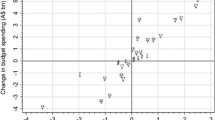Abstract
Between 1997 and 2000 the Australian government introduced three policy reforms that aimed to increase private health insurance coverage and reduce public hospital demand. The first provided income-based tax incentives; the second gave an across-the-board 30% premium subsidy; and the third introduced selective age-based premium increases for those enrolling after a deadline. Together the reforms increased enrolment by 50% and reduced the average age of enrollees. The deadline appeared to induce consumers to enroll now rather than delay. We estimate a model of individual insurance decisions and examine the effects of the reforms on the age and income distribution of those with private cover. We interpret the major driver of the increased enrollment as a response to a deadline and an advertising blitz, rather than a pure price response.
Similar content being viewed by others
References
Abraham, J. M., Vogt, W. B., & Gaynor, M. (2002). Household demand for employer-based health insurance. NBER Working Paper 9144.
Australian Bureau of Statistics (ABS). (2001). Government benefits, taxes and household income, 1998–99, publication no. 6537.0.
Australian Bureau of Statistics (ABS). (2002). National Health Survey 2001, Confidentialised Unit Record Files. For a summary of results see http://www.ausstats.abs.gov.au/ausstats/subscriber.nsf/Lookup/90A3222FAD5E3563CA256C5D0001FD9D/$File/43640_2001.pdf.
Barrett G.F., Conlon R. (2003). Adverse selection and the contraction in the market for private health insurance: 1989–1995. The Economic Record 79, 279–296, doi:10.1111/1475-4932.00104.
Besley T., Hall J., Preston I. (1999). The demand for private health insurance: Do waiting lists matter. Journal of Public Economics, 72, 155–181. doi: 10.1016/S0047-2727(98)00108-X.
Buchmueller T.C., Couffinhal A., Grognon M., Perronnin M. (2004). Access to physician services: Does supplemental insurance matter? Evidence from France, 2004. Health Economics 13, 669–687. doi:10.1002/hec.879.
Butler, J. R. G. (1999). Estimating elasticities of demand for private health insurance in Australia. NCEPH Working paper Number 43.
Butler J.R.G. (2002). Policy change and private health insurance: Did the cheapest policy do the trick?. Australian Health Review 25(6): 33–41
Choi, J. J., Laibson, D., Madrian, B. C., & Metrick, A. (2005). Optimal defaults and active decisions. NBER Working Paper 11074, Cambridge, MA.
Colombo, F., & Tapay, N. (2004). Private health insurance in OECD countries: The benefits and costs for individuals and health systems. In OECD towards high-performing health systems (Chap. 6). Paris: OECD.
Costa-Font J., Font-Vilalta M. (2004). Preference for National Health Service use and the demand for private health insurance in Spain. Geneva Papers on Risk and Insurance 29, 705–718. doi: 10.1111/j.1468-0440.2004.00312.x.
Cutler D.M., Zeckhauser R.J. (2000). The anatomy of health insurance. In: Culyer J.A., Newhouse J.P. (eds). Handbook of health economics (Vol IA, Chap 11). Amsterdam, Elsevier, pp. 563–643
Ettner S.L. (1997). Adverse selection and the purchase of Medigap insurance by the elderly. Journal of Health Economics 16, 543–562. doi: 10.1016/S0167-6296(97)00011-8.
Finkelstein A. (2002). The effect of tax subsidies to employer-provided supplementary health insurance: Evidence from Canada. Journal of Public Economics 84(3): 305–339. doi: 10.1016/S0047-2727(00)00155-9.
Frech H.E., III, Hopkins S., MacDonald G. (2003). The Australian health insurance boom: Was it subsidies or liberalised regulation?. Economic Papers 22(1): 58–64
Gruber, J., & Ebonya, W. (2003). Subsidies to employee health insurance premiums and the health insurance market. NBER Working Paper 9567. Cambridge, MA.
Hall J., De Abreu Lourenco R., Viney R. (1999). Carrots and sticks — the rise and fall of private health insurance in Australia. Health Economics 8, 653–660. doi :10.1002/(SICI)1099-1050(199912)8:8<653::AID-HEC491>3.0.CO;2-I.
Hall, J., & Savage, E. (2005). The role of the private sector in the Australian healthcare system. In A. Maynard (Ed.), The public-private mix for health (pp. 247–278). Abingdon: Radcliffe Publishing Ltd.
Harmon C., Nolan B. (2001). Health insurance and health services utilization in Ireland. Health Economics 10, 135–145. doi: 10.1002/hec.565.
Hopkins S., Zweifel P. (2005). The Australian health policy changes of 1999 and 2000: An evaluation. Applied Health Economics and Health Policy 4(4): 229–238. doi: 10.2165/00148365-200504040-00005.
Johnson E.J., Bellman S., Lohse G.L. (2002). Defaults, framing and privacy: Why opting in-opting out. Marketing Letters 13(1): 5–15. doi: 10.1023/A:1015044207315.
Laibson D. (1997). Golden eggs and hyperbolic discounting. The Quarterly Journal of Economics 112(2): 443–477. doi:10.1162/003355397555253.
Madrian B.C., Shea D. (2001). The power of suggestion: Intertia in 401(k) participation and savings behavior. The Quarterly Journal of Economics 116(4): 1149–1187. doi:10.1162/003355301753265543.
O’Donoghue T., Rabin M. (1999). Doing it now or later. The American Economic Review 89(1): 103–124
Palangkaraya A., Yong J. (2005). Effects of recent carrot-and-stick policy initiatives on private health insurance coverage in Australia. The Economic Record 81, 262–272. doi:10.1111/j.1475-4932.2005.00260.x.
Private Health Insurance Administration Council (PHIAC). (2004). Report on the operations of the registered health benefits organisations, available at http://www.phiac.gov.au.
Propper C. (2000). The demand for private health care in the UK. Journal of Health Economics 19(6): 855–876. doi:10.1016/S0167-6296(00)00045-X.
Savage E., Wright D. (2003). Moral hazard and adverse selection in Australian private hospitals: 1989–90, 2003. Journal of Health Economics 22, 331–359. doi:10.1016/S0167-6296(02)00104-2.
Thaler R.H., Benartzi S. (2004). 2004, Save more tomorrow: Using behavioral economics to increase employee saving. The Journal of Political Economy 112(1): S164–S187. doi:10.1086/380085.
Tversky, A., & Kahneman, D. (1986). Rational choice: The contrast between economics and psychology (pp. 67–74). Chicago and London: University of Chicago Press.
Author information
Authors and Affiliations
Corresponding author
Rights and permissions
About this article
Cite this article
Ellis, R.P., Savage, E. Run for cover now or later? The impact of premiums, threats and deadlines on private health insurance in Australia. Int J Health Care Finance Econ 8, 257–277 (2008). https://doi.org/10.1007/s10754-008-9040-4
Received:
Accepted:
Published:
Issue Date:
DOI: https://doi.org/10.1007/s10754-008-9040-4




